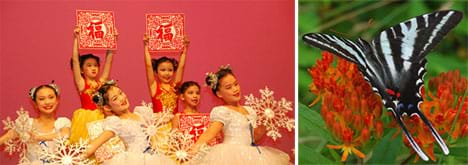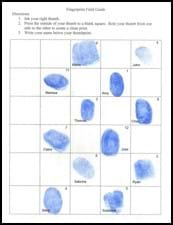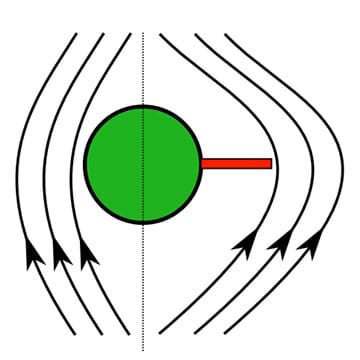Quick Look
Grade Level: 6 (5-7)
Time Required: 1 hour
Expendable Cost/Group: US $0.20
Group Size: 1
Activity Dependency: None
Subject Areas: Earth and Space
Summary
Students apply several methods developed to identify and interpret patterns to the identification of fingerprints. They look at their classmates' fingerprints, snowflakes, and "spectral fingerprints" of elements. They learn to identify each image as unique, yet part of a group containing recognizable similarities.
Engineering Connection
Understanding patterns is crucial to any engineer, whether it be an electrical engineer who must understand patterns involved in circuitry or an aerospace engineer fitting pieces of a spacecraft together. In the context of these activities, however, engineers need to understand the patterns in the physical world that help them build the tools to expand our knowledge of that world.
Learning Objectives
After this activity, students should be able to:
- Describe the differences and similarities between patterns and fingerprints.
- Extend a numerical and alpha-numerical pattern.
- Recognize patterns present in the natural world.
- Understand why pattern recognition is an important skill for engineers.
Educational Standards
Each TeachEngineering lesson or activity is correlated to one or more K-12 science,
technology, engineering or math (STEM) educational standards.
All 100,000+ K-12 STEM standards covered in TeachEngineering are collected, maintained and packaged by the Achievement Standards Network (ASN),
a project of D2L (www.achievementstandards.org).
In the ASN, standards are hierarchically structured: first by source; e.g., by state; within source by type; e.g., science or mathematics;
within type by subtype, then by grade, etc.
Each TeachEngineering lesson or activity is correlated to one or more K-12 science, technology, engineering or math (STEM) educational standards.
All 100,000+ K-12 STEM standards covered in TeachEngineering are collected, maintained and packaged by the Achievement Standards Network (ASN), a project of D2L (www.achievementstandards.org).
In the ASN, standards are hierarchically structured: first by source; e.g., by state; within source by type; e.g., science or mathematics; within type by subtype, then by grade, etc.
Common Core State Standards - Math
-
Generate two numerical patterns using two given rules. Identify apparent relationships between corresponding terms. Form ordered pairs consisting of corresponding terms from the two patterns, and graph the ordered pairs on a coordinate plane.
(Grade
5)
More Details
Do you agree with this alignment?
International Technology and Engineering Educators Association - Technology
-
Develop innovative products and systems that solve problems and extend capabilities based on individual or collective needs and wants.
(Grades
6 -
8)
More Details
Do you agree with this alignment?
State Standards
Colorado - Math
-
Use number relationships to find the missing number in a sequence.
(Grade
4)
More Details
Do you agree with this alignment?
Materials List
Each group needs:
- Pencil or pen
- Index cards (1 per student)
- Copy of the Fingerprint Field Guide
To share with the entire class:
- Patterns Presentation (ppt)
- Overhead transparency of Fingerprint Field Guide
- Master overhead of Finger Print Field Guide
- Ink pad (2)
Worksheets and Attachments
Visit [www.teachengineering.org/activities/view/cub_spect_activity1] to print or download.Pre-Req Knowledge
Students should be able to recognize and describe patterns, and have some experience interpreting data. They should understand that visible light represents only a small portion of all light. It is helpful if students have a general understanding of energy.
Introduction/Motivation
(Display "Patterns in Nature" transparency on the overhead or use the PowerPoint presentation.) What do you think this image could be? (Have the class discuss the clues they used to identify the images.) What clues did you use to decide what the images could be? (Reveal the answer key on the overhead.) Natural processes create organized geometrical patterns. These patterns can be found in a variety of places in nature. Have you ever looked closely at a leaf or a butterfly? Patterns exist all around us. Humans have created some tools to help us understand patterns better. Mathematical concepts, such as geometry, were created to explain the physical world and to help us decipher some of these patterns. Engineers use patterns to help them design better instruments. Engineers also create new instruments to study these patterns so that we can understand them better. Let's look at some more patterns and see if you can figure out what is going on. (Display the "Numbers and Patterns" transparency. Give students a few minutes to figure out the puzzles, and then ask members of the class for their answers.)
Procedure
Background
The light patterns in this activity are emission spectra produced by hydrogen and helium gas. Every gas has a unique pattern, so we can identify the gas based on the lines that appear in the spectrum. An emission spectrum is seen as bright lines against a dark background, and is produced by light (or energy) passing through hot gas, and the gas emitting photons. The pattern depends on the type of gas.
Before the Activity
- The day before the activity, create the "Fingerprint Field Guide" page and a set of anonymous fingerprints.
- Using the inkpad, have each student make a thumbprint on the "Fingerprint Field Guide" page and write his or her name under the print.
- At the same time, have students make an identical thumbprint on an index card. (Note: Keep the index cards in order of the prints on the Field Guide so you can number them accurately after the students are gone.)
- Assign a number to the fingerprint on the Field Guide and its corresponding index card. Number these randomly so students do not see a pattern on the Field Guide when they match the cards later.

- Copy the "Fingerprint Field Guide" onto two overhead transparencies, one with students' names and one without the names.
- Hand out copies of the anonymous prints.
- Copy "Patterns in Nature," "Numbers and Patterns," and "Sample Spectra" sheets to overhead transparencies or use the PowerPoint presentation.
With the Students
Part 1: Fingerprint Detectives
- Have the class arrange their desks in a large circle.
- Divide the class into pairs, and distribute to each team a copy of the "Fingerprint Field Guide."
- Explain that you will pass out one index card to each pair.
- Explain that students are to match the numbered fingerprint to one of the prints on the "Fingerprint Field Guide."
- Give students one minute (or choose another limit you think is appropriate) to make the identification. Then they are to pass the card to the team on their right. In this way, each team has the same amount of time to identify each fingerprint on the index cards.
- Circulate around the room as students work. Listen to their conversations and observe them as they work to understand the processes they use to identify the numbered fingerprints.
- Ask students to explain the processes that they used to match known and unknown prints. Make a list of methods and solutions students developed while trying to match numbered prints to named prints.
- Review the list and ask students to discuss or expand on the processes and identify which methods were most successful.
- As a class, review the prints and identify the owner of each numbered print. (Use the overhead transparency of the "Fingerprint Field Guide" to enlarge the images and look for details.)
- Ask students to compare the processes used identify patterns and fingerprints. What were the similarities and differences? How does recognizing a pattern compare to looking for unique characteristics? How are fingerprints alike and at the same time unique?
Part 2: Spectral Fingerprints
- Project the sample spectra overhead transparency for the students to see.
- For each image set, ask the students the following questions:
- Do you recognize these images?
- What can you tell me about the patterns?
- Compare and contrast the images, what are some of the similarities and differences?
- Are these examples of fingerprints or patterns?
- Point out that the images of colored bands are known as "spectral fingerprints" and that they represent the absorption and emission of energy by individual elements.
- Explain that like human fingerprints, spectral fingerprints are unique to each element and help scientists to identify the composition of many substances including mineral and gases.
- Bring closure to the activity by asking students to summarize the similarities and differences between patterns and fingerprints in a graphic organizer such as a "T-chart" or Venn diagram. Encourage students to list how patterns and fingerprints appear and how they are used to help us understand the world around us.
Assessment
Pre-Activity Assessment
Assessing Prior Knowledge: Ask students to draw or write what they think of when they hear the word "pattern."
Activity Embedded Assessment
Class Discussion: Ask students why it is important for engineers to understand the patterns in the natural world. To begin the discussion, ask about familiar patterns such as the lines on a CD-rom (connected to sound patterns, a natural pattern). Some examples (if students are having difficulty) include: engineers can send a spacecraft to a planet because the planets move around the Sun in a specific pattern that repeats, engineers can use sonograms and other technology to create underground maps (patterns) that help determine where bridges and buildings can be safely built; some structures, like the honeycomb pattern in a beehive, are strong structures that help engineers build better structures etc.
Post-Activity Assessment
Compare and Contrast: Have students summarize the similarities and differences between patterns and fingerprints in a graphic organizer such as a "T-chart" or Venn diagram. Encourage students to list how patterns and fingerprints appear and how engineers use them to help us understand the world around us.
Crime Scene Investigators and Engineering: Engineers help create technologies to help us identify fingerprints for criminal investigations. For example, they develop the computer programs that recognize specific fingerprint patterns. They also help develop the techniques to retrieve fingerprints from different surfaces, such as metals. Have the students think about the different ways they identified the fingerprints in the "Fingerprint Field Guide." Using the methods they discovered, have them pretend to be engineers and create a written procedure for identification of fingerprints that could be converted into a computer program for their local police department.
Troubleshooting Tips
Severely vision-impaired and blind children will have difficulty with portions of this activity. Students with corrective lenses will not have difficulty.
It may be good to have an extra set of brainteasers available if students are interested.
Activity Extensions
Continue the spectroscopy unit by completing the associated activity, Graphing the Rainbow.
Have students create a list of other patterns they have seen in nature.
Have students create their own alpha numeric brainteaser to share with the class.
Engineering Connection: Biomimicry: Engineers often use the natural world as inspiration for design. Biomimicry means to study nature's ideas and patterns and imitate them to solve human problems. Some of these designs include air- and sea-going vessels, medical imaging devices, and water and pollution treatment processes. Have students think of and discuss technologies that mimic patterns in nature, such as solar cells that mimic cell patterns in leaves.
Subscribe
Get the inside scoop on all things TeachEngineering such as new site features, curriculum updates, video releases, and more by signing up for our newsletter!More Curriculum Like This

Students learn about nondestructive testing, the use of the finite element method (systems of equations) and real-world impacts, and then conduct mini-activities to apply Maxwell’s equations, generate currents, create magnetic fields and solve a system of equations. They see the value of NDE and FEM...
References
"NIEHS Kids Page: Brainteasers, Puzzles & Riddles." April 27, 2004. The NIEHS Office of Management. March 4, 2005. http://www.niehs.nih.gov/kids/braint.htm
"Absorption Spectra." Physics2000/University of Colorado. March 4, 2005. http://www.colorado.edu/physics/2000/quantumzone/fraunhofer.html
Copyright
© 2007 by Regents of the University of Colorado.Contributors
Laboratory for Atmospheric and Space Physics, University of Colorado at BoulderSupporting Program
Laboratory for Atmospheric and Space Physics (LASP), University of Colorado BoulderAcknowledgements
The contents of this digital library curriculum were developed under a grant from the Fund for the Improvement of Postsecondary Education (FIPSE), U.S. Department of Education, and National Science Foundation GK-12 grant no 0338326. However, these contents do not necessarily represent the policies of the Department of Education or National Science Foundation, and you should not assume endorsement by the federal government.
Last modified: October 29, 2024






User Comments & Tips